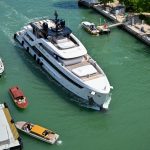Ulysses got off to a very unfortunate start on the high seas. Originally commissioned by billionaire businessman, Graeme Hart, she was damaged by fire shortly before completion and then relocated to Brisbane for a two-year campaign of redesign, reconstruction and upgrade work. This involved no fewer than 200 people from 30 companies working to replace not just the entire superstructure but also 1,500 square metres of interior space.
It was an epic task costing around 30 million Australian dollars, but the boat that finally emerged in 2006 was a huge success, winning the Australian Refit of the Year Award and taking her place as one of the most capable Expedition Yachts money could buy.

Expedition credentials
Named after the hero of Homer’s epic ‘Odyssey’, Ulysses exhibits an external form halfway between that of a military survey vessel and a commercial icebreaker. While some high-end yachts are built for island-hopping in the glamorous playgrounds of the Med or the Caribbean, this is a craft designed to shrug off oceanic swells and ice-strewn Arctic waters with the ease of a purpose-built commercial workhorse – and the Australian redesign obviously played a big part in making that happen.

Murray Owen, MD of Marine Engineering Consultants (www.marineeng.com.au), was closely involved with the refit – and as he intimates, the combination of a steel hull and an aluminium superstructure was central to her success: ‘By replacing the steel superstructure with lighter aluminium, the GM (centre of gravity) was made lower, giving much greater stability.’
This is of such importance because the vertical elevation of the craft’s five-tier design might easily have put too much weight up high, damaging the boat’s ability to recover from a heeling moment in lively seas. These lightweight topsides therefore play a key part in improving composure during exposed offshore passages.
However, it is also good to see that the builders have eschewed the fragile catwalk gloss of a fiberglass hull and opted instead for the heavyweight credentials of steel. It offers outstanding resistance to impact and abrasion, plus great structural strength and easy, affordable repairs. In short, with a thick steel hull and tough, low-maintenance, corrosion-proof aluminium topsides, Ulysses is one of the most durable and resilient superyachts around.
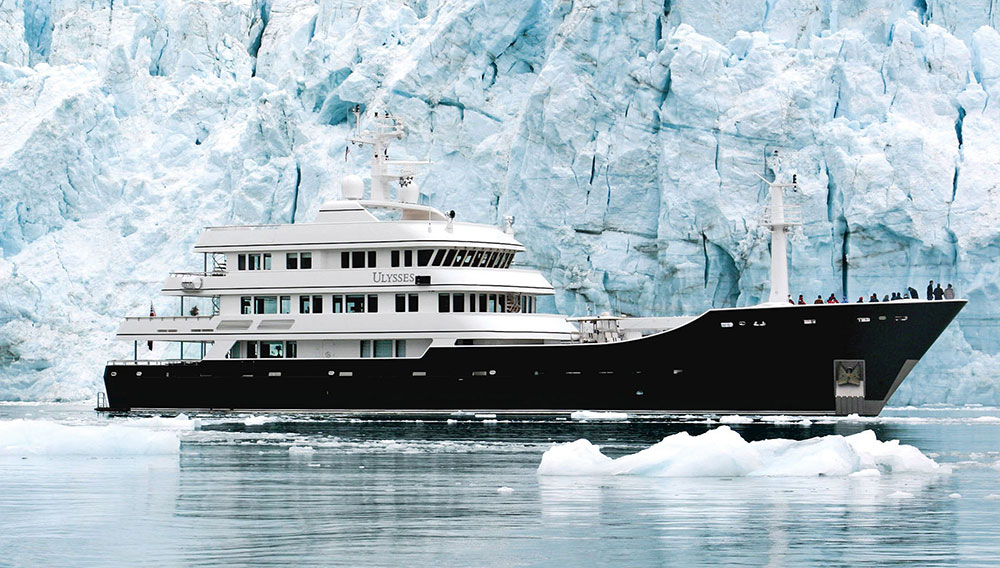
Hybrid hull shape
Despite her uncompromising external form, it would be wrong to describe this yacht as an icebreaker. A vessel specifically designed for such work tends to employ a reinforced bow, a vast reserve of low-end torque and a hull designed to minimise friction as broken ice rolls down the sides. Its frontal shape might also be rather bulbous and flat, allowing downward weight (rather than forward cleaving) to break through an ice sheet. However, features of this kind can produce some unpleasant seakeeping traits (a slamming bow and exaggerated pitch and roll) that would prove ruinously painful for a long-distance skipper – so again, Ulysses adopts a more pleasing hybrid approach.
Up at the bow, in place of the broad, open suntraps so celebrated by the superyacht world, you get a boldly elevated structure with the massively raised freeboards of a serious offshore passage-maker. With a bulbous subsurface profile allied to a relatively angled stem and flare-free hull sides, her cruising range is also radically improved. In fact, twin Caterpillar diesels and a 176,000-litre fuel tank mean she can cruise at 12 knots for 6,000 nautical miles non-stop – in other words, enough to cross the entire north Atlantic, from Britain to the U.S. with 2,400 miles still safely in hand.
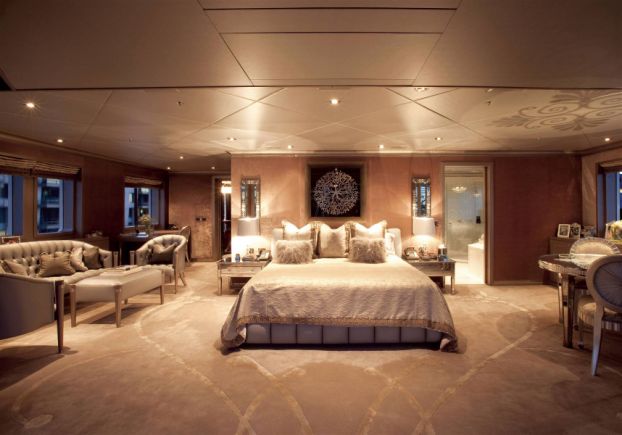
Internal opulence
She may be a potent oceangoing craft but Ulysses is also a vessel of great opulence. Up on deck, in addition to two spa pools, you get a pair of Yamaha FX1100 PWs, a 4.5-metre Gemini and a 350hp jet-driven Naid RIB, all deployed by a pair of 20-tonne cranes. It’s an impressive fleet of tenders but if you want to upgrade the toy collection, you could add a helicopter on the retractable helipad, plus a 13-metre RIB and even a submarine on that vast expanse of foredeck. As Mr Owen explains, it’s another nod toward her expedition prowess: “Where other superyachts need a shadow vessel to carry all the toys and equipment for an expedition, Ulysses can manage by herself while still having the luxury you would expect.”
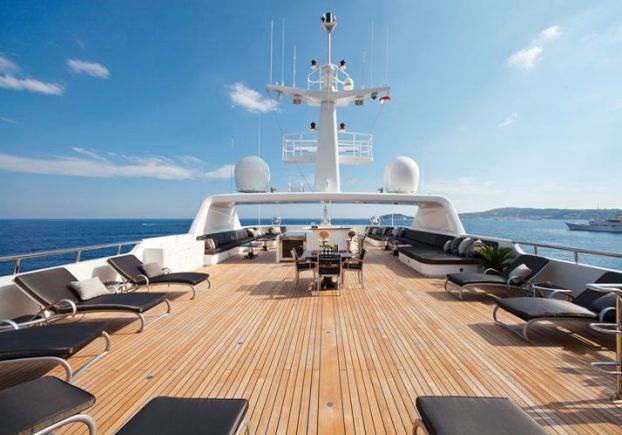
Take a closer look at the internal arrangement and Mr Owen’s words certainly ring true. A generous 11-meter beam enables Ulysses to swallow 19 guests and 14 crew with great ease and yet the owner’s stateroom remains pleasantly remote. Separated from the 13 lower deck cabins by two levels, it comes with its own office, bathroom and private dining area. Meanwhile, up top, the sundeck is truly enormous for a craft of this size, with an arc of sunbeds around a central Jacuzzi, plus a barbecue, a shaded bar and a crow’s nest. And down on the middle deck, the full-beam sky lounge boasts not just a pool table and pinball machine but a bar that serves both the internal salon and the external dining deck. It’s another first-rate party option on a craft already bursting with communal versatility.
Summary
This thoroughly satisfying interpretation of the established superyacht formula makes a great many less substantial craft seem rather silly and trifling. With enormous gravity of build, style and purpose, she is a stoic workhorse in a world of frivolous show ponies – and while her hull shape undoubtedly carries a pungent commercial resonance, her internal fit-out is well able to hold its own among the world’s most exalted craft.
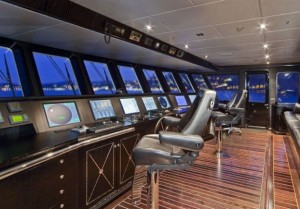
Expedition Yacht Ulysses: Specifications
Length overall: 59.6 metres
Beam overall: 11.0 metres
Displacement: 966 tonnes
Draught: 2.8 metres
Building material: steel/aluminium
Fuel capacity: 176,000 litres
Sleeping capacity: 19 guests plus 14 crew
Builder: Trinity Yachts
Engines: Twin Caterpillar 3512B
Top speed: 15 knots
Range: 6,000NM
Price: USD $36.50m (GBP £22.11m)
For more about cruising the high seas on a luxury superyacht, read Safira: Expedition Megayacht with an Ecological Conscience.
Related

